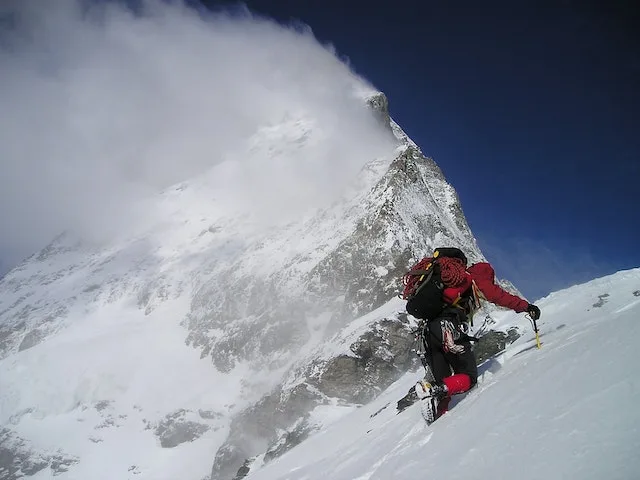When considering how to fit mountaineering boots, you first need to consider what category of boot will help you achieve your goals in the mountains. In picking a category of boot you should consider what types of objectives you have in mind. Some questions to ask yourself include:
Will I be climbing vertical ice, neve, snow or rock?
Will I be hiking long distances to get to the climb?
How cold is it going to get?
Will I be spending nights in the mountains or just day tripping?

Mountaineering boot sizing
Proper sized boots will go a long way to increase your comfort on the mountain. You'll be handling enough challenges as it is as you venture towards to summit and blisters on your feet should not be on your list of things to overcome.
You can use this handy size chart to determine what size fits you best.
Mountaineering boot construction
Mountaineering boots come in 2 different construction options: Plastic and Leather.
Plastic mountaineering boots: Plastic boots, as described have a plastic outsole that provides a rigid upper boot and added protection. These boots are warm and relatively cheaper than the alternatives. They are very stiff and will not flex as much, meaning they can be slightly clunkier. This may be worth it if you’re traveling on ice and rocky terrain.
Leather mountaineering boots: Leather boots provide more flex and dexterity meaning they are easier to walk in and they will stretch slightly to fit your feet better. These boots are still warm, but the single leather boots will not be as warm as the double leather or single plastics. Leather boots are also lighter-weight and have diverse lace-up options.
Choosing between Plastic vs Leather Mountaineering boots
Like all other gear, boots have undergone a rapid evolution over the last 20 years with plastic boots slowly being replaced by synthetic or leather models.
You may still find places recommending plastic double boots and most rental facilities carry this style of climbing boot. These older styles still work well and are extremely durable. However, if you’re starting fresh with them and they aren’t broken in, they can cause shin-bang and other foot issues due to their extreme rigidity.
If you’re using new boots we highly recommend focusing on boots with an outer shell made of synthetics or leather. For personal use their durability is excellent and if treated well and cared for, they will easily last for dozens of major expeditions.
Mountaineering boot types
There are three main types of mountaineering boots, outlined below. Each has it's own set of considerations and benefits depending on the conditions of your climb.
Single Mountaineering Boots: Single boots are lightweight and may, or may not, have a toe welt, but they will always have a heel welt. These are fantastic boots for low elevation and warmer climbs such as Mt. Rainier, Mt. Baker and the Australian Alpine Academy in July and August. However, in the greater ranges they are too light to provide adequate warmth against cold and storms.
Double Mountaineering Boots: Double boots are made up of an outer boot shell and removable inner boot, a construction providing additional warmth for colder weather and moderate to high altitudes. One major benefit of a double boot is that the inner liner can be removed and dried in your sleeping bag. This makes them a great choice for longer trips (even on lower elevation, or warmer climbs). You’ll find you use a good pair of double boots for most of your climbs around the world. They quickly take the place of a single boot and are far more versatile.
Triple Mountaineering Boots: Made up of an outer insulating gaiter, boot shell, and inner liner, triple boots are ideal for extreme cold (Denali & Vinson) and high altitude climbs (Everest, Manaslu etc) and are critical on those peaks. Their exceptional warmth will hold frostbite at bay, but make them a poor choice for warmer weather climbs as your feet get too hot and are likely to sweat profusely. Wet feet are going to cause significant discomfort and foot issues during your expedition.
We hope this guide will help you select the boot that is best for you and your next adventure. And if you need any boots or other equipment don't hesitate to rent it from the GeerGarage community.
